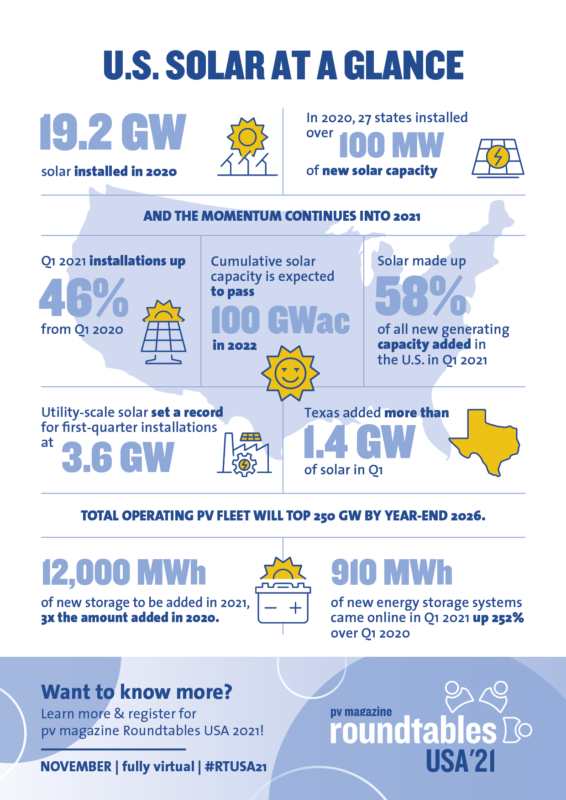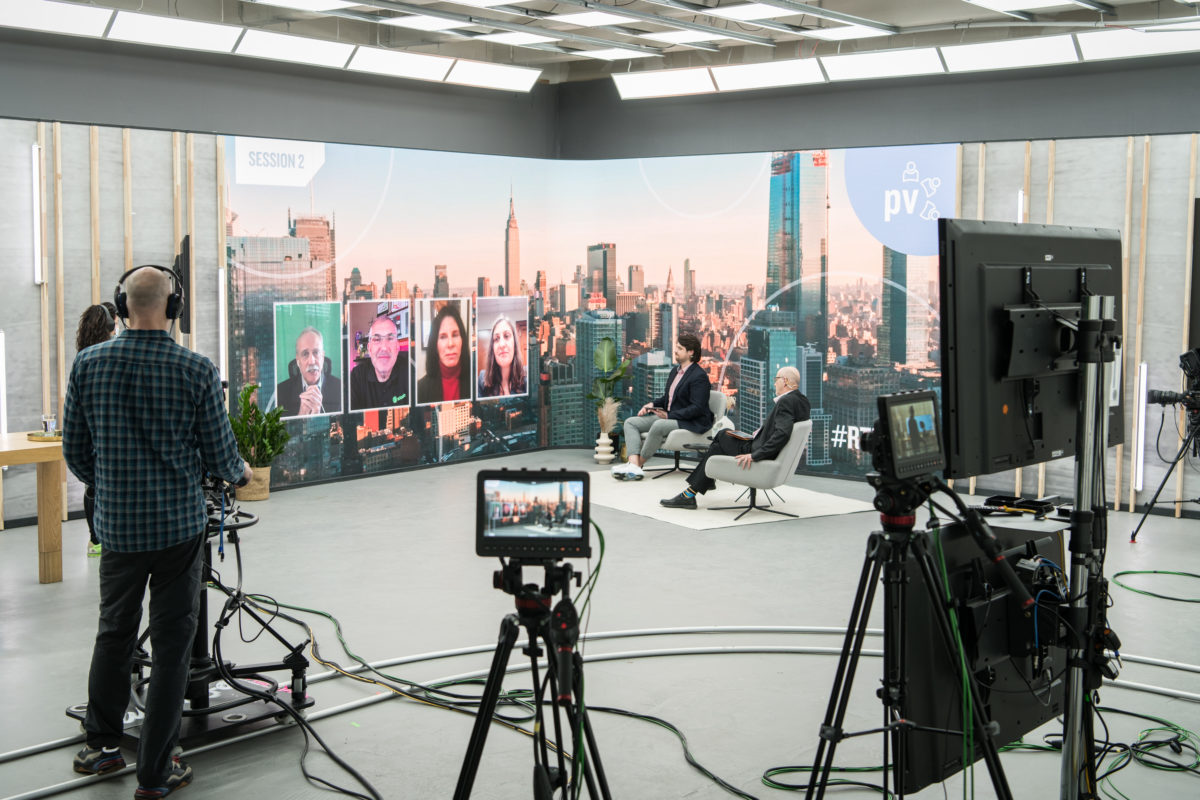That's a wrap!
The event has concluded, and what an informative day it was. We spoke with experts and industry leaders, policy makers and innovators about the present and future of the solar industry. We learned about solar infrastructure resiliency in an age of extremes, and what needs to be done to accelerate deployment in the U.S. and worldwide.
Thank you to all who attended, including all viewers, panelists, and speakers. Thank you to our sponsors to the event. We look forward to seeing you next year, and at our international Roundtables events!
Solar cleantech innovation to drive a decarbonized future
Speakers:
Chris Gordon, manager, project development, EDF Renewables North America
Karl Rábago, principal, Rábago Energy, LLC
Marlene Motyka, US and global renewable energy leader, Deloitte
Massoud Amin, professor, department of electrical and computer engineering, University of Minnesota
Motyka: Nations are currently operating with over 50% renewable penetration with no reliability issues.
Gordon: Distribution scale is where the industry is headed. Generation should be sited near load centers. This poses a high land-cost issue, as well as NIMBY concerns. Local zoning laws are slowing development.
Rábago: The path forward to the best value capture is the inclusion of both distributed AND utility-scale.
Now presenting: Innovation in battery chemistry, and challenges in insuring new tech
Ann Marie Augustus – co-founder, VP of operations, Urban Electric Power:
UEP reworks chemistry found in alkaline batteries (double AA) and makes it rechargable.
Zinc and manganese used in the batteries are much more abundant than lithium, offering a low-cost alternative.
The tech is safer, no issues of thermal runway.
George Schulz, VP, Clean Energy at Ariel Re:
New technologies present challenges for insurance underwriting.
Data is king when creating impactful insurance. There is a lack of data transparency in existing and emerging technologies.
Now presenting: Heterojunction modules
Vartan Oskanian, advisor to the CEO, Recom, and Hamlet Tunyan, CEO Recom present: Heterojunction modules: technology, supply chains, and innovation.
Tunyan: Recom is still considering a heterojunction gigafactory in the U.S.
Recom module whitepapers provide extra levels of transparency showing where its supply chain originates. It also traces the total carbon emission output in its module creation, which it said is lower than industry averages.
Heterojunction combines silicon and thin-film technologies.
Michael Parr: The environmental footprint of solar
Parr:
A large amount of manufacturing (70-90%) is located in China.
Chinese solar has nearly double the carbon emissions of the rest of the world.
If manufacturing continues solely in China, within 20 years carbon emissions could double the global emissions of the aluminum industry.
A geographically diverse manufacturing supply chain is needed.
Ossoff and Demings bills create a web of policies that will expand manufacturing in the U.S.
Market demand will be the strongest force for reducing carbon. Buyers must actively select low-carbon module sourcing, which will spur manufacturing in low-carbon regions.
Up next: How to reduce solar's environmental footprint
[ROUNDTABLES] Off to our first panel for this second #RTUSA21 session 🚀
🎙What solar needs to expand ☀
Coming up 🔜 @ultralowcarbon's Executive Director, Michael Parr, on #solar’s environmental footprint 🌍
Tune back in: https://t.co/obFCsHap0e#pvmagazine #digitalevent pic.twitter.com/6enmt6i0R6
— pv magazine USA (@pvmagazineusa) November 9, 2021
Live discussion: What solar needs to expand
Speakers:
Suzanne Leta, head of policy and strategy at SunPower
Elizabeth Sanderson, exec. director at Solar Energy International
Dean Solon, founder, Shoals Technologies Group
Paul Wormser, VP of technology at Clean Energy Associates
Leta: One of the best ways we can address the soft costs of permitting is through automated permitting. This is widely available from DOE-backed SolarAPP+
Sanderson: 30% of the solar workforce are women, 8% are Black. The industry needs to address these diversity shortcomings.
DOE Deputy Director Garrett Nielsen - Solar Futures
Nielsen:
Decarbonization plus electrification could save $1.7 trillion in net savings through 2050.
About 0.5% of total land area of the entire U.S. is estimated to be needed to decarbonize the grid. (1/80th the land used for agriculture.)
Securing the domestic supply chain is a chief concern of the DOE.
Long-term policy efforts are being considered, but the low cost of energy and market forces are driving the bulk of solar growth.
Up next: U.S. Department of Energy Deputy Director Garret Nilsen
DOE's deputy director Garrett Nielsen will present a keynote discussion on solar futures.
He will be followed by a panel discussion “Lead, follow, or get out of the way: What solar needs to expand”
This talk will be led by Suzanne Leta, head of policy and strategy at SunPower, Elizabeth Sanderson, exec. director at Solar Energy International, Dean Solon, founder, Shoals Technologies Group, and Paul Wormser, VP of technology at Clean Energy Associates.
Several more discussions will follow. Stay tuned – we resume at 2:00 PM EST!
Next up: Digital controls and AI
[ROUNDTABLES] Time for fireside chats 🔥
🎙 STS´ Frederic Dross & @staubligroup's Brian Mills for a spotlight on Performance 💎
🔜 @TerabaseEnergy's Matt Campbell & @NEXTracker's Aron Dobos discussing digital controls and AI ⚙
👉 https://t.co/obFCsHap0e#pvmagazine #RTUSA21 pic.twitter.com/JuHoQOsy88
— pv magazine USA (@pvmagazineusa) November 9, 2021
Connectors a leading cause of issues
Brian Mills, head of alternative energy, North America, Stäubli:
Connectors are causing frequent, severe issues. Power losses, overheating, or ARC failures.
Compatibility issues, mismatch lead to failures about 3-5 years out.
Performance issues across the solar value chain
Next up: We put a spotlight on performance issues across the solar value chain! DC cable mismatch issues and recent trends in quality specs in purchase agreements are discussed by Brian Mills (Stäubli) and Frédéric Dross (STS).
Issues of large-format modules
Honbing Fang, director of product marketing, LONGI:
While thicker glass for large format modules may decrease microcracking and other related issues, it raises costs. LONGI has been focused instead on increasing overall efficiency of the modules.
Deep dive into module reliability
[ROUNDTABLES] We are deep diving into modules' reliability now! 🔥
🎙 Learn more about the ripple effects of a shift to large-format modules as we welcome @longi_solar's Director of Product Marketing, Hongbin Fang 👋
Join us: https://t.co/obFCsHap0e
#pvmagazine #RTUSA21 pic.twitter.com/6TozFZTp5P
— pv magazine USA (@pvmagazineusa) November 9, 2021
EL imaging as a quality assistance tool
Claire Kearns-McCoy, senior project manager/solar engineer, Clean Energy Associates:
“EL is a great way to validate proper installation techniques and procedures.”
Experts address PV resiliency in extreme weather
[ROUNDTABLES] We just kicked off the #RTUSA21!
NOW🎙 A panel discussion on strategies to harden solar assets from climate-driven extreme weather 🌪
Coming up 🔜 @CEA_Global´s Solar Engineer, Claire Kearns-McCoy!
Tune in 👉 https://t.co/obFCsHap0e#pvmagazine #digitalevent pic.twitter.com/ow8ik4PRfa
— pv magazine USA (@pvmagazineusa) November 9, 2021
Follow our Roundtables event!
[ROUNDTABLES] The #RTUSA21 is now LIVE ⏺
🎙Now: @karlaloeb from @SEIA opens the event with a Spotlight on #resiliency!
Coming up 🔜 Panel discussion with @SandiaLabsUVM, @PVEvolutionLabs, Endurans Solar and VDE Americas ☀
Tune in: https://t.co/IB435ymV78#pvmagazine pic.twitter.com/u6BbbkPrdX
— pv magazine USA (@pvmagazineusa) November 9, 2021
Resiliency in an age of extremes
Karla Loeb, board of directors, DG division chair, Solar Energy Industries Association (SEIA):
For resilience: “We need energy where people live, not just in areas that support our industrial processes.”
The show is underway!
Our first session tackles quality and performance from multiple perspectives. We talk about critical issues facing solar and storage and drill down to more detailed discussion of inverters, trackers, and modules.
Session 1: Optimizing systems and hardware to meet environmental and performance challenges.
The show starts soon!
Our hosts are ready for an informative event!
Need to register? Click here.
Follow the action!
The 2021 Roundtables USA event begins today at 10:00 AM EST! We look forward to your participation.
Need to register? Click here.

